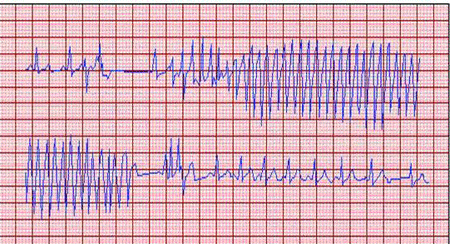Resumen
Definición
Anamnesis y examen
Principales factores de diagnóstico
- paciente inconsciente
- ausencia de respiración normal
- ausencia de circulación
- alteración del ritmo cardíaco
Factores de riesgo
- arteriopatía coronaria (AC)
- disfunción ventricular izquierda
- edad
- cardiomiopatía hipertrófica (CMH)
- displasia ventricular derecha arritmogénica (ARVD)
- síndrome del segmento QT largo (SQTL)
- medicamentos que prolongan el intervalo QT o que provocan alteraciones electrolíticas
- emergencia médica o quirúrgica aguda
- envenenamiento
- síndrome de Brugada
- cardiopatía valvular
- tabaquismo
- antecedentes de trastornos de la alimentación
Pruebas diagnósticas
Primeras pruebas diagnósticas para solicitar
- monitorización cardíaca continua
- hemograma completo (HC)
- electrolitos séricos
- GSA
- biomarcadores cardíacos
- ecografía en el punto de atención (POCUS)
Pruebas diagnósticas que deben considerarse
- electrocardiograma (ECG)
- angiografía coronaria
- ecocardiograma
- pruebas de esfuerzo con ejercicio
- radiografía de tórax
- cribado toxicológico
- resonancia magnética cardíaca
- angiografía coronaria por tomografía computarizada
- electrocardiograma de señal promediada (SAECG)
- estudio electrofisiológico
Algoritmo de tratamiento
paro cardíaco no presenciado
ritmos que se pueden tratar con choque eléctrico (taquicardia ventricular sin pulso o fibrilación ventricular)
ritmos que no se pueden tratar con choque eléctrico (actividad eléctrica sin pulso o asistolia)
regreso de la circulación espontánea
ausencia de regreso de la circulación espontánea
Colaboradores
Autores
John Wink, MD
Emergency Physician
Alberta Health Services
Alberta
Canada
Divulgaciones
JW declares that he has no competing interests.
Eddy Lang, MD
Professor and Department Head of Emergency Medicine
Cumming School of Medicine
University of Calgary
Alberta Health Services
Calgary
Canada
Divulgaciones
EL declares that he has no competing interests.
Agradecimientos
Dr John Wink and Professor Eddy Lang would like to gratefully acknowledge Dr Amar Krishnaswamy and Dr Arman T. Askari, previous contributors to this topic.
Divulgaciones
AK and ATA declare that they have no competing interests.
Revisores por pares
Vaikom Mahadevan, MD
Professor of Medicine
Division of Cardiology
University of California
San Francisco
CA
Divulgaciones
VM declares that he has no competing interests.
Anthony Aizer, MD, MS
Instructor
NYU Department of Medicine (Cardiology)
Leon H Charney Heart Rhythm Center and New York University
New York
NY
Divulgaciones
AA declares that he has no competing interests.
Massimo F. Piepoli, MD, PhD, FESC
Honorary Clinical Senior Lecturer/Consultant
Department of Cardiology
Imperial College London
London
UK
Divulgaciones
MFP declares that he has no competing interests.
Agradecimiento de los revisores por pares
Los temas de BMJ Best Practice se actualizan de forma continua de acuerdo con los desarrollos en la evidencia y en las guías. Los revisores por pares listados aquí han revisado el contenido al menos una vez durante la historia del tema.
Divulgaciones
Las afiliaciones y divulgaciones de los revisores por pares se refieren al momento de la revisión.
Referencias
Artículos principales
Panchal AR, Bartos JA, Cabañas JG, et al. Part 3: adult basic and advanced life support: 2020 American Heart Association guidelines for cardiopulmonary resuscitation and emergency cardiovascular care. Circulation. 2020 Oct 20;142(16_suppl_2):S366-468.Texto completo Resumen
Martin SS, Aday AW, Almarzooq ZI, et al. 2024 heart disease and stroke statistics: a report of US and global data from the American Heart Association. Circulation. 2024 Feb 20;149(8):e347-913.Texto completo Resumen
Zeppenfeld K, Tfelt-Hansen J, de Riva M, et al. 2022 ESC Guidelines for the management of patients with ventricular arrhythmias and the prevention of sudden cardiac death. Eur Heart J. 2022 Oct 21;43(40):3997-4126.Texto completo Resumen
Al-Khatib SM, Stevenson WG, Ackerman MJ, et al. 2017 AHA/ACC/HRS guideline for management of patients with ventricular arrhythmias and the prevention of sudden cardiac death. Circulation. 2018 Sep 25;138(13):e272-391.Texto completo Resumen
Greif R, Bray JE, Djärv T, et al. 2024 International consensus on cardiopulmonary resuscitation and emergency cardiovascular care science with treatment recommendations: summary from the basic life support; advanced life support; pediatric life support; neonatal life support; education, implementation, and teams; and first aid task forces. Resuscitation. 2024 Dec;205:110414.Texto completo Resumen
Nolan JP, Sandroni C, Böttiger BW, et al. European Resuscitation Council and European Society of Intensive Care Medicine guidelines 2021: post-resuscitation care. Resuscitation. 2021 Apr;161:220-69.Texto completo Resumen
Artículos de referencia
Una lista completa de las fuentes a las que se hace referencia en este tema está disponible para los usuarios con acceso a todo BMJ Best Practice.

Guías de práctica clínica
- Critical care management of patients after cardiac arrest: a scientific statement from the American Heart Association and Neurocritical Care Society
- 2024 International consensus on cardiopulmonary resuscitation and emergency cardiovascular care science with treatment recommendations
Más Guías de práctica clínicaFolletos para el paciente
Vía respiratoria con máscara laríngea
Ventilación con bolsa-válvula-máscara
Más Folletos para el pacienteVideos
Demostración animada de una punción de la arteria radial
Demostración animada de una punción de la arteria femoral
Más vídeosInicie sesión o suscríbase para acceder a todo el BMJ Best Practice
El uso de este contenido está sujeto a nuestra cláusula de exención de responsabilidad
